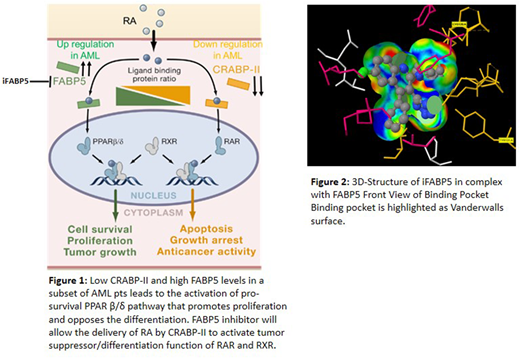Abstract
Introduction: Retinoic acid (RA), the active metabolite of vitamin A, influences biological processes by activating the retinoic acid receptor (RAR). RARs are ligand-controlled transcription factors that function as heterodimers with retinoid X receptors (RXRs) to regulate homeostasis of cellular growth. The success of RAR modulation in the treatment of acute promyelocytic leukemia (APL) particularly by the use of all-trans retinoic acid (ATRA) has stimulated considerable interest in the development of small molecules that can modulate RAR and RXR. Recent studies have demonstrated that RA can also activate the peroxisome proliferator-activated receptor β/δ (PPARβ/δ). In the aqueous intracellular milieu, RA is transported by the cellular retinoid-binding protein CRABP-II, or by the fatty-acid-binding protein FABP5, depending on the ratio of FABP5 to CRABP-II. In cells expressing high CRABP-II and low FABP5, RA activates the RAR, whereas in the presence of the reverse ratio, RA activates PPARβ/δ (Fig 1). These two different modes of RA delivery due to the different ratio of these two cargos leads to opposite cellular outcomes. Cells harboring high level of CRABP-II, RA is delivered to RAR leading to apoptosis, growth arrest, and anticancer activity. However, when FABP5 expression is high, RA is delivered to PPARβ/δ resulting in survival, proliferation, and tumor growth. In both cases, retinoid X receptor (RXR) is the indispensable partner of the nuclear receptor involved. Therefore, preventing FABP5 from such antagonism may be a novel therapeutic strategy for AML. Here we report the development of a therapeutic strategy based on a highly specific FABP5 inhibitor (iFABP5) (Fig 2) that will allow the delivery of RA by CRABP-II to activate tumor suppressor function of RAR and RXR. Methods: An iterative approach of design synthesis and activity were employed to select the most potent hit, iFABP5, for further experiments. Expression levels were analyzed by western blot analysis and qRT-PCR. Colony forming assays were used to analyze iFABP5 activity against AML cell lines. Flow cytometry based cell differentiation assay were performed to assess the efficacy of iFABP5 and ATRA combination treatment. Results: The analysis of TCGA data set revealed that a certain class of AML patients (pts) (Trisomy 8 AML) have low levels of CRABP-II and high levels of FABP5, presumably due to gene duplication, that in part explains the inability of ATRA to induce terminal differentiation in AML cells. To test our hypothesis, we screened AML and APL patient (pt) bone marrow cells and found that a number of AML pts bone marrow have high FABP5 and low CRABP-II protein levels while the ATRA responding APL pts has opposite ratio determined by western blotting. Therefore, low CRABP-II and high FABP5 levels in a subset of AML pts lead to the activation of pro-survival PPARβ/δ pathway that promotes proliferation and opposes the differentiation. We also analyzed AML and APL pt samples along with different AML cell lines for mRNA expression using qRT-PCR. High FABP5 levels were observed in the majority of the AML cell lines. Efficacy of novel small molecule FABP5 inhibitor as a single agent and in combination with ATRA was evaluated in HL-60 cells. The FABP5 inhibitor iFABP5 was found to increase differentiation at 72 hours as assessed by both CD11b and CD14 levels in HL-60 cells. To confirm that iFABP5 is targeting FABP5 and indirectly targeting the PPARβ/δ pathway, levels of RAR and PPARβ/δ target genes were evaluated in the absence and presence of iFABP5. Changes in the gene expression of RAR and PPARβ/δ target genes in the presence and absence of iFABP5 were also examined in shFABP5, shPPARβ/δ, and shCRABP2 versus wild type cells. Conclusion: We demonstrated that a small molecule inhibitor of FABP5 synergizes with ATRA and induces the differentiation in AML cells. High FABP5 levels (mRNA and protein) were observed in the majority of the AML cell lines. Hence, FABP5 can be a therapeutic target in AML. Utilizing virtual screening and structurally guided design, we developed a small molecule FABP5 inhibitor that induces monocytic differentiation as observed by increased CD14 surface expression as a single agent and in combination with ATRA. FABP5 is not only a strong target to treat AML pts but also an excellent approach for developing a novel therapeutic for pts where FABP5 expression and activity is high.
Maciejewski:Alexion Pharmaceuticals, Inc.: Consultancy, Membership on an entity's Board of Directors or advisory committees, Speakers Bureau; Apellis Pharmaceuticals: Consultancy; Ra Pharmaceuticals, Inc: Consultancy; Apellis Pharmaceuticals: Consultancy; Alexion Pharmaceuticals, Inc.: Consultancy, Membership on an entity's Board of Directors or advisory committees, Speakers Bureau; Ra Pharmaceuticals, Inc: Consultancy. Carraway:Agios: Consultancy, Speakers Bureau; Amgen: Membership on an entity's Board of Directors or advisory committees; Balaxa: Membership on an entity's Board of Directors or advisory committees, Speakers Bureau; Celgene: Membership on an entity's Board of Directors or advisory committees, Research Funding, Speakers Bureau; FibroGen: Consultancy; Jazz: Speakers Bureau; Novartis: Speakers Bureau.
Author notes
Asterisk with author names denotes non-ASH members.


This feature is available to Subscribers Only
Sign In or Create an Account Close Modal